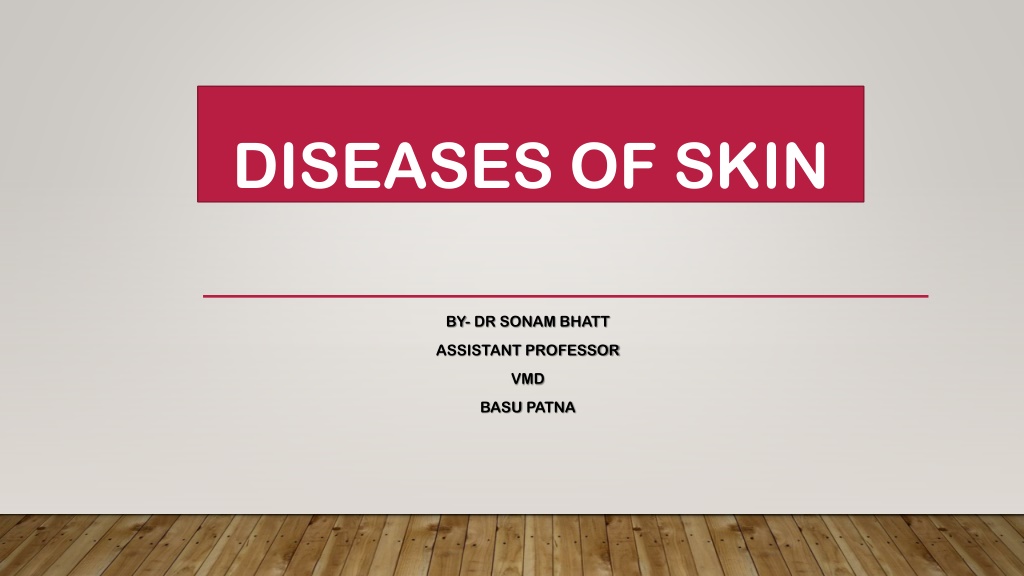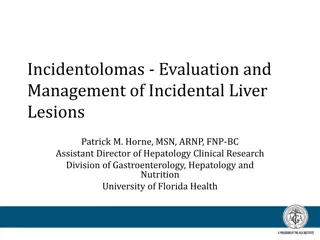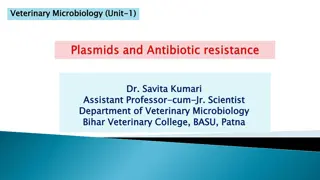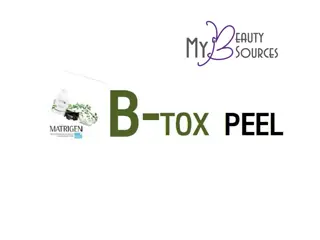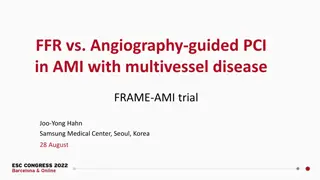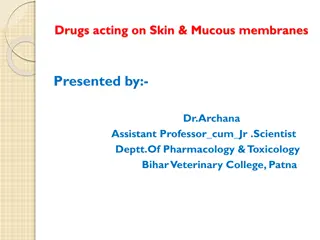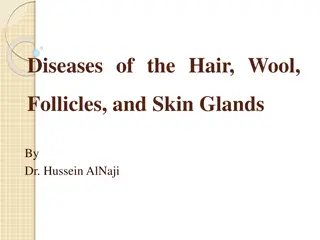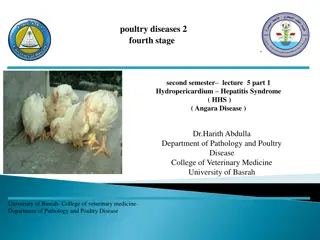Diseases of Skin Overview and Primary Lesions by Dr. Sonam Bhatt, Assistant Professor VMD Basu Patna
Skin, the largest organ of the body, plays a crucial role in regulating temperature and acting as a protective barrier. It consists of the epidermis, dermis, and subcutis, along with skin appendages like hair and claws. Skin lesions can be categorized into primary and secondary, with primary lesions being directly reflected on the skin. Primary skin lesions include macules, papules, plaques, and nodules, each with distinctive characteristics. Understanding these lesions is essential for diagnosing and treating various skin conditions. [Word count: 86]
Download Presentation

Please find below an Image/Link to download the presentation.
The content on the website is provided AS IS for your information and personal use only. It may not be sold, licensed, or shared on other websites without obtaining consent from the author. Download presentation by click this link. If you encounter any issues during the download, it is possible that the publisher has removed the file from their server.
E N D
Presentation Transcript
DISEASES OF SKIN BY- DR SONAM BHATT ASSISTANT PROFESSOR VMD BASU PATNA
INTRODUCTION Largest organ of the body Provides regulates temperature, a protective barrier against the environment, 3 major layers: the epidermis or outermost layer, the dermis or middle layer, and subcutis or innermost layer Other - skin appendages (such as hair and claws) & subcutaneous muscles & fat
SKIN LESIONS Primary Primary lesion lesion- - directly reflected on the skin & are independent in origin Secondary Secondary lesion lesion may owe their origin from the course of primary lesions or from some remote areas other than skin. Ex: FMD, RP Primary lesion: 2 types; Localised & generalized
PRIMARY SKIN LESIONS Macule Macule (macula (macula spot) spot): :circumscribed flat top having difference of color from surrounding Not elevated above skin surface Macular lesion extending over more than one centimeter in diameter is patch patch Produced by vasodilation; less pigmentation or hyperpigmentation
Papule Papule (pimple) centimeter in diameter. (pimple): : solid elevation over the skin around or less than one Size may vary pin head to pea Pink or red in color Swelling is caused by cellular infiltrations, metabolic products, allergic response or hyperplasia May originate from follicle or non-follicle Follicular papule: result of bacterial, fungal & parasitic infection Non- follicular : allergic in origin Elevated flat topped papules are known as lichenoid
Plaque Plaque: : solid elevation with flat top having the diameter of more than a centimeter Observe in acute allergic condition Lesions are predominantly noticed over neck, thorax & referred as vegetation Nodule Nodule (tubercle) (tubercle): : solid circumscribed mass extending into dermis is nodule Larger papule greater than one cm are considered as nodules Appear as a result of inflammatory or neoplastic reactions Larger Larger lesion lesion is is known known as as node node Hypoderma bovis produces nodular lesion in cattle
V Vesicle(bulla) esicle(bulla): : small fluid filled elevation of the superficial epithelium of the skin Fluid consists of serum & lymph which accumulate between epidermal or dermal layers Large Large vesicle vesicle is is known known as as bulla bulla Soft in character & fragile in nature Mostly observed as a result of viral infection, contact irritants or auto-allergy Ex- pox lesion Superficial Superficial thin as as impetigo impetigo thin walled walled vesicle vesicle with with surrounded surrounded erythema erythema is is known known
Pustule Pustule: : vesicles filled with pus May result due to inflammation May be considered as superficial minute abscess May originate from bacterial infection or a vesicle of pox lesion may turn into pustules due to secondary bacterial infection Wheal Wheal ( (urticaria urticaria, , hive) flat topped lesions hive): : circumscribed semisolid elevated round or Due to allergic reaction Insect bites, stings or allergen may induce wheal
SECONDARY SKIN LESIONS Scale( Scale(squame squame, , flake) keratinous debris over the skin surface flake): : excessive accumulation of discarded Remains as bran like deposition over the skin It is the discharge of sebaceous & sweat glands which are dried up. This dried up materials form thin layers & fall of which is known as dandruff dandruff or or pityriasis pityriasis Ex- ectoparasitic or mycotic infection, nutritional deficiency
Crust Crust (scab) (scab) dried discharge of exudate on the skin Ex sheep scab, dermatophyllosis, ringworm crust Crust which result from slough due to burn is known as eschar Erosion Erosion : : loss of superficial layer of the skin without any breach of the basement membrane. Healing tendency U Ulcer lcer : : breach in the continuity of epidermis Less healing tendency to heal May result due to break down of vesicles or pustules
Excoriation Excoriation superficial erosion of the skin Occurs due to pruritis Mechanical damage by scratching is responsible for excoriation Ex- Sarcoptes scabies Scar : Scar : it is formed by the proliferation of fibrous tissue in an area replacing healed up lesions it is devoid of hairs & atrophic Scar is formed following traumatic damage, ulceration, surgical intervention & cauterisation
Lichenification Lichenification: thickening & hardening of tissues Results due to chronic inflammatory process May develop following self-inflicted trauma or ectoparasitism Lichenification manifested with manifested hyperplastic changes of stratum spinosum is known as acanthosis Fissure (crack, Fissure (crack, rhagade rhagade) ): spilt of the skin Elasticity of the skin is lost in this condition Chap: Chap: small fissure extending to the subcutaneous layer Pigmentation
Other histological lesions : Parakeratosis Parakeratosis- - imperfect keratinisation of corneal layer Seen in pigs due to deficiency of skin Hyperkeratosis Hyperkeratosis corneum : excessive thickening of stratum Occur due to inflammation, dietary deficiency or traumatisation Acne : Acne : inflammation of hair follicle
PRURITIS ( ITCHING) Sensation that gives rise to the desire of scratching Peripheral or central in origin Peripheral pruritis: Many ectoparasite eg sarcoptes, notoedres, ticks etc may produce irritation of epidermis & resultant itching Deep seated lesions do not produce itching Mainly observed in muco- cutaneous junction (plenty of pain receptors )
Central Central pruritis pruritis: : stimulation of itching centre in the medula may initiate scratching reflexes Depends on structural configuration as observed in pseudo rabies in pig or scrapie in sheep Diseases like hepatitis, diabetes mellitus, nervous form of ketosis may produce itching in animals
MANAGEMENT OF PRURITUS In peripheral origin, skin scrapings should be examined for ectoparasites & appropriate acarisidal treatment should be extended Central origin can be controlled by sedative Application of soothing agents Use of antihistaminics or corticosteroids Regulation of diet. Addition of essential fatty acids in the diet
